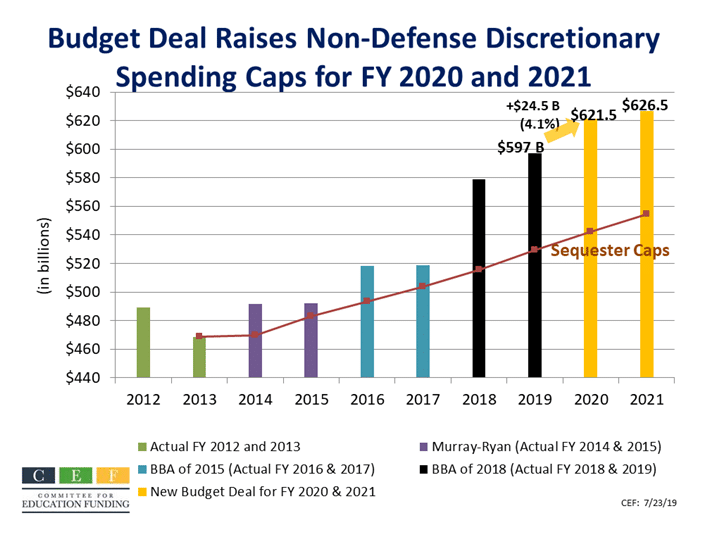Deal Struck to Raise FY20 & FY21 Budget Caps
 Energized by the need to raise the debt ceiling of the United States by early September, congressional leaders and the Administration struck a deal to raise the discretionary spending caps as established in the Budget Control Act of 2011 on July 22, 2019. In addition, the deal suspends the debt ceiling through July 2021, preventing the debt ceiling from being entangled in the 2020 election campaigning and the associated political maneuvering.
Energized by the need to raise the debt ceiling of the United States by early September, congressional leaders and the Administration struck a deal to raise the discretionary spending caps as established in the Budget Control Act of 2011 on July 22, 2019. In addition, the deal suspends the debt ceiling through July 2021, preventing the debt ceiling from being entangled in the 2020 election campaigning and the associated political maneuvering.
Known as the Bipartisan Budget Agreement for Fiscal Years 2020 and 2021, the proposed legislation still needs to pass the U.S. House of Representatives (House) and the U.S. Senate (Senate), both of which intend to take up the measure before the August recess. This sets the stage for the FY20 appropriations process to move forward, although there will be a Continuing Resolution (CR) passed before September 30 to give the House and Senate time to conference their bills. The Senate Appropriations Committee has not moved any of the 12 appropriations bills through the subcommittee and full committee process, and the House has passed 10 of the 12 bills. The House moved the Labor, Health and Human Services, Education, and Related Agencies (Labor-H) bill in a “minibus” that included the Defense bill—reminiscent of last year’s efforts that led to the two bills signed together into law before the end of the fiscal year. While the Senate Appropriations Committee currently intends to move both Labor-H and Defense bills together through their process, it is unclear if this will be maintained based on the budget deal. The deal does specify that the Congress shall avoid an omnibus, a bill that includes all 12 appropriations bills with no stance on minibuses illuminated.
This deal sets the defense discretionary cap at $667 billion for FY20 and $672 billion for FY21 and sets the non-defense discretionary cap at $622 billion for FY20 and $627 billion for FY21. This means we can expect a tight year in FY21 given the small increase of $5 billion over FY20 for non-defense discretionary funding.
For now, the next step to watch is the allocation of funding to each of the 12 appropriations bills in the Senate. The Labor-H bill contains approximately 33% of the non-defense discretionary, but it has never received 33% of the increased funding. The allocation will determine if the Senate keeps any of the increases that the House passed to programs important to the profession, including the Teacher Quality Partnership grant program, the Special Education Personnel Preparation grant program, and Title II of the Every Student Succeeds Act.
Tags: federal issues, funding






